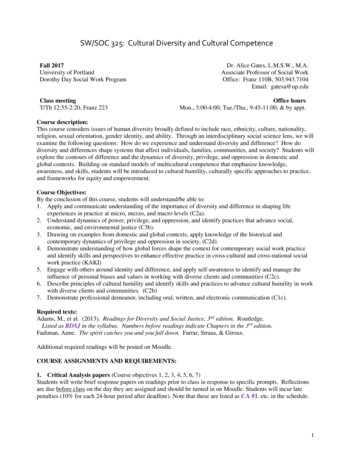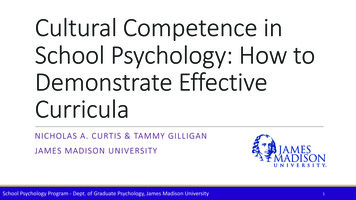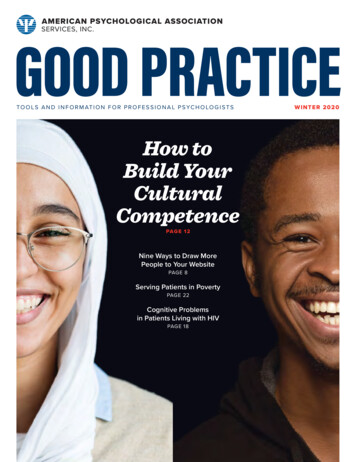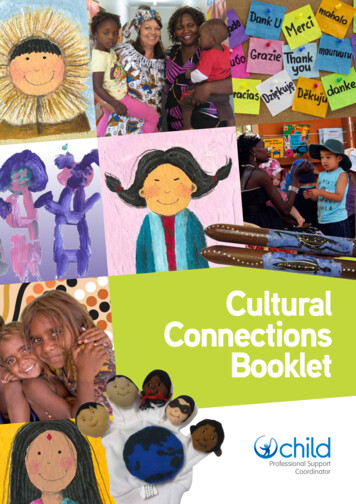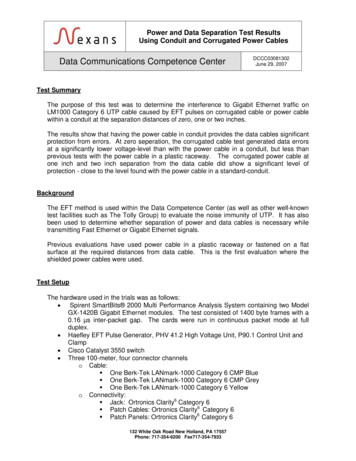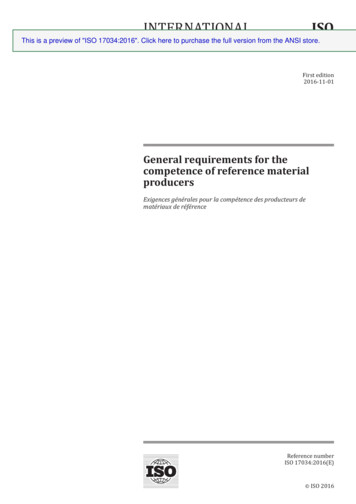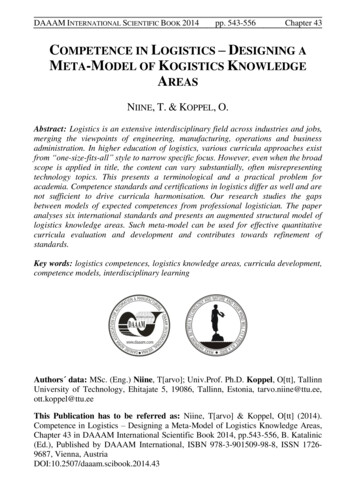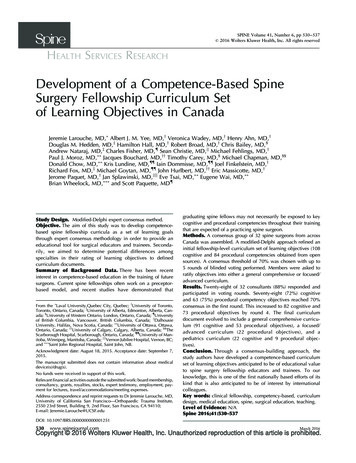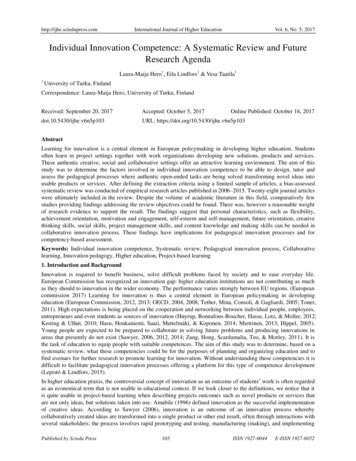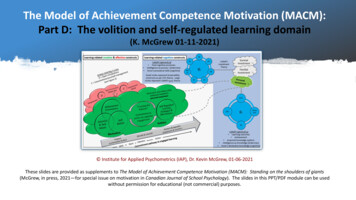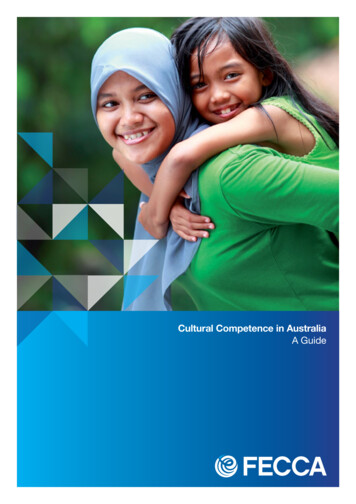
Transcription
Cultural Competence in AustraliaA Guide
FECCA NATIONAL OFFICEUnit 1, No. 4 Phipps Close, Deakin ACT 2600PO Box 344, Curtin ACT 2605T: 61 02 6282 5755E: admin@fecca.org.auwww.fecca.org.au 2019 Federation of Ethnic Communities’ Councils of AustraliaNo part of this publication may be reproduced without writtenpermission of FECCA.FECCA received funding from the Australian GovernmentDepartment of Home Affairs to produce this publication.
ContentsINTRODUCTION3DIVERSITY AND CULTURAL COMPETENCE IN AUSTRALIAN ORGANISATIONS4WORKFORCE DIVERSITY:THE CAUSALITY DILEMMA AND CULTURAL COMPETENCE TRAINING6IMPROVING ORGANISATIONAL CULTURAL COMPETENCE8CULTURAL COMPETENCE TRAINING11CULTURAL COMPETENCE TRAINING PROGRAMS IN AUSTRALIA12WHAT DOES GOOD CULTURAL COMPETENCE TRAINING LOOK LIKE?15ORGANISATIONAL UPTAKE OF CULTURAL COMPETENCE TRAINING IN AUSTRALIA17APPENDIX 1: REFERENCES21APPENDIX 2: GLOSSARY23APPENDIX 3: METHODOLOGY26APPENDIX 4: EXAMPLE ASSESSMENT CHECKLIST27APPENDIX 5: CULTURAL COMPETENCE TRAINING IN AUSTRALIA29
2Federation of Ethnic Communities’ Councils of Australia
IntroductionCultural competence is the ability to understand,communicate and effectively interact across cultures. Itis commonly defined as:‘ a set of congruent behaviours, attitudes andpolicies that come together in a system, agencyor among professionals and enable that system,agency or those professionals to work effectively incross-cultural situations’.1There is an organisational and an individual aspect tocultural competence. At the individual level, developingcultural competence requires acknowledgment ofone’s own cultural assumptions, values and beliefs. Itinvolves understanding that culture shapes worldview,and that individuals view the world differently basedon their cultural background and related experiences.Cultural competence includes an awareness thatindividuals have different needs because of theircultural and linguistic background. Improving culturalcompetence ensures better and more effectivecommunication with individuals from a range of culturaland linguistic backgrounds.Cultural competence at the organisational levelinvolves developing systems, policies and processesthat ensure cultural diversity and difference areconsidered in all aspects of an organisation’s work.Organisations with high levels of cultural competencefoster successful, diverse workforces, using culturaldifference as a strength for more effective decisionmaking, innovation and adaptability. They alsounderstand the needs and preferences of a diverserange of consumers and provide products and servicesthat are appropriate, accessible and inclusive.As culture is a dynamic, complex and constantlychanging construct, there is no point at which culturalcompetence is ‘achieved’. Developing individual ororganisational cultural competence is an open-endedprocess of improving attributes, skills, degrees ofknowledge, policies and strategies which1234together enhance the ability to communicate acrosscultures. Cultural competence is developed on aspectrum, rather than through mastery of a skillset orpractice. Developing cultural competence requires acommitment to ongoing learning, reflection and diverseand inclusive practices.A workforce that reflects Australia’s diverse cultural andlinguistic society leads to increased levels of culturalcompetency. However, organisations need to improvecultural competency to recruit and support a diverseworkforce in the first instance. Cultural competencetraining, policies and processes are a means throughwhich an organisation can improve its culturalcompetence and develop and support diversity inthe workplace.In 2006, the then named Commonwealth Departmentof Immigration and Multicultural Affairs funded CulturalDiversity Services2 to undertake a year-long studyof cultural competence through an examination ofthe effectiveness of cross-cultural training3 across arange of Australian organisations.4 The 2006 reportfound shortcomings in the development of culturalcompetence across organisations, inconsistent qualityand oversight of the cross-cultural training industry, andchallenges for organisations in identifying appropriatecross-cultural training providers.Against the background of the 2006 research, thisreport examines how cultural competence has evolvedover the last decade and its continuing relevancefor Australian government, for-profit and communityorganisations.This report, Cultural Competence in Australia: A Guide,explores: the importance and benefits of developing culturallyand linguistically diverse workforces and its linkwith organisational cultural competence markers of organisational cultural competence cultural competence training.Cross TL et al, ‘Towards a Culturally Competent System of Care Vol. 1.’ 1989, Georgetown University Child Development x.php.Since 2006 there have been shifts in preferred terminology from ‘cross-cultural’ to ‘cultural competence’.Bean R Cultural Diversity Services Pty Ltd , ‘The Effectiveness of Cross-Cultural Training in the Australian Context’, 2009, available at ing-in-the-australian-context.Cultural Competence in Australia: A Guide3
Diversity and culturalcompetence inAustralian organisationsAustralia’s cultural and linguistic diversity is increasing.According to the 2016 Census data, one third ofAustralians were born overseas and nearly 50 per centof Australians have one or more parent born overseas.In 2016, there were over 300 separately identifiedlanguages spoken and more than one fifth (21 percent) of Australians spoke a language other thanEnglish at home.5The diversity of the Australian population is, however,not reflected in Australian organisations. In 2016, theAustralian Human Rights Commission reported that: among the 201 Chief Executives of ASX 200companies, 77% had an Anglo-Celtic backgroundand 18% have a European background, and only5% have non-European backgrounds in the Australian Parliament, 79% of electedmembers in the House of Representatives and theSenate had an Anglo-Celtic background. Less than4% have a non-European background within the Federal Ministry, 86% have an AngloCeltic background, one Minister had an Indigenousbackground and none had a non-Europeanbackground of the 124 heads of federal and state governmentdepartments, less than 2% of leaders had a nonEuropean background. 6567894Research demonstrates that culturally and linguisticallydiverse (CALD) Australians experience many barriers,including racism and discrimination, in recruitment andpromotion. For example, candidates with names linkedto specific ethnicities need to apply for considerablymore job vacancies before being short-listed for aninterview. As compared with applicants with AngloCeltic names, Aboriginal and Torres Strait Islanderpeople must submit 35 per cent more applications,those with Chinese names must submit 68 per centmore, Italian names require 12 per cent more and‘Middle Eastern’ names 64 per cent more applications.7Australians of migrant background are forced touse strategies that de-emphasise racial or culturalbackground, for example: Anglicising their name andomitting overseas work experience or qualifications —even if relevant to the application.8These types of barriers are not confined to point ofrecruitment. Employees should have equal access topromotion and progression regardless of their culturalor linguistic background. In many industries, includingfinancial services, hospitality and the CommonwealthPublic Service, cultural and linguistic diversity isvisible in entry and mid-level positions and technicalspecialities, but absent in senior management andexecutive roles. A diverse organisation requires diversityto be visible at all levels of the organisation.Alongside equal opportunity in employment,Australia’s multicultural society also requiresorganisations to deliver products and services thatmeet the needs of a culturally and linguistically diverseconsumer base. FECCA’s research and consultationsundertaken for this report9 and other work on access,equity and inclusion, shows that service provisionacross government, for-profit and communitysectors is not resulting in equitable outcomes forAustralian consumers who identify as culturally andlinguistically diverse (CALD).Australian Bureau of Statistics, ‘Census reveals a fast changing, culturally diverse nation’, 27 July 2017, available at ia%20Release3.Australian Human Rights Commission, ‘Leading for Change A blueprint for cultural diversity and inclusive leadership’, 2016, available at /document/publication/2016 AHRC%20Leading%20for%20change.pdf.Crawford School of Public Policy, ‘Job hunt success is all in a name’, 4 March 2013, available at ob-huntsuccess-all-name & Booth, A. L., Leigh, A., & Varganova, E. (2012). Does ethnic discrimination vary across minority groups? Evidence from a field experiment.Oxford Bulletin of Economics and Statistics, 74(4), 547–573.Kosny, A., Santos, I. & Reid, A. Int. Migration & Integration (2017) 18: 483.See Appendix 3: MethodologyFederation of Ethnic Communities’ Councils of Australia
Poorly designed services and products mean thatCALD Australians may be prevented from accessingopportunities available to many other Australiansbecause: individuals or communities do not know that theservice exists or is available to them products and services do not consider needs ofconsumers with limited English proficiency products and services do not consider culturalneeds products and services do not consider the needsof consumers with low digital proficiency or whocannot access digital services insufficient consideration is given to how themigration experience impacts CALD consumers (forexample: a lack of trust of authority creating barriersto access; or difficulties for migrants in meetingdocumentation requirements meaning delayed orno access to services).A commitment to improving cultural competenceenables an organisation to develop workforce diversityand to ensure that services and products are designedto include all consumers, regardless of cultural orlinguistic background.Cultural Competence in Australia: A Guide5
Workforce diversity:the causality dilemmaand culturalcompetence training Diverse organisations adapt, innovate and makedecisions more effectively. Teams with differentqualifications, backgrounds and experiences maytake a more innovative approach to problem-solvingand introduce alternative ways of thinking resultingin more effective decision-making.Research suggests that diverse organisations aremore successful. McKinsey & Co have consistentlyfound that diversity in corporate leadership teamspositively correlates with financial performance. In2018, McKinsey found that companies with the mostethnically/culturally diverse executive teams were 33%more likely to outperform their peers on profitability.10 Diverse organisations attract a larger, morevaried and qualified pool of potential employees.Organisations that demonstrate a commitment todiversity and inclusion in their recruitment practicesare more successful in attracting highly-skilledemployees. Diverse teams provide links to diversenetworks from which to attract talent. The greater thetalent pool, the more likely organisations can find themost appropriately qualified and skilled employees.It is difficult to identify the exact causal link betweendiversity and successful performance. However,there are some discernible advantages in diverseorganisations that may explain the link, for example: Diverse organisations can better identifyconsumer need. Culturally and linguisticallydiverse organisations can design, develop anddeliver products and services from a broad rangeof perspectives, that more accurately reflect thediversity of the Australian population.Increased diversityin the workforce1011126 Diverse organisations provide a happier,more harmonious workplace. Diverseorganisations can offer greater levels of employeesatisfaction as perceptions of fairness and inclusioncorrelate with employee well-being.11 This leads toimproved employee retention and commitment toan employer.12In other words, a diverse workforce leads to increasedlevels of cultural competence.Improved culturalcompetenceProducts andservices that meetthe needs of diverseconsumer baseMcKinsey & Company, ‘Delivering through Diversity’, 2018, available at https://www.mckinsey.com/ livering-through-diversity full-report.ashx.Liora Findler PhD , Leslie H. Wind PhD & Michálle E Mor Barak PhD, 2007, The Challenge of Workforce Management in a Global Society, Administration in SocialWork, 31:3, 63-94, DOI: 10.1300/J147v31n03 05.Martin, J. (2013). Seven imperatives for diverse and inclusive organizations. Strategic HR Review, 12(3), 151-152.Federation of Ethnic Communities’ Councils of Australia
Diversity increases the capacity of an organisationto come together to work effectively in cross-culturalsituations — for example: in designing products andservices for a multicultural consumer base; and in strivingto create a fair and inclusive workplace for all employees.However, this presents a causality dilemma: if diverseorganisations help to develop cultural competencewithin organisations, organisations need to improveculturally competence to recruit and support a diverseworkforce in the first instance.Cultural competence training, policies andprocesses are a means through which an organisationcan improve its cultural competence, develop andsupport diversity in the workforce and better ensurethat pr
interview. As compared with applicants with Anglo-Celtic names, Aboriginal and Torres Strait Islander people must submit 35 per cent more applications, those with Chinese names must submit 68 per cent more, Italian names require 12 per cent more and ‘Middle Eastern’ names 64 per cent more applications.7 Australians of migrant background are forced to use strategies that de-emphasise racial .
